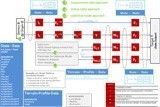-
StatusOngoing
-
Status date2011-11-06
-
Activity Code7-.022
The objective of this activity is to design, develop and publish a database that provides relevant statistical data for the design of tracking systems for mobile satellite terminals. The activity includes gathering the data (by measurement campaign, acquiring and/or tailoring existing data) and developing a database so that data can be accessed by antenna and system designers.
The main objective of this activity is the characterisation of the user terminal dynamics of satellite communication systems on the move. The current and future needs of the antenna manufacturing industry w.r.t. the contents and functionality of a database describing user terminal dynamics for various platforms and environments have to be accounted for.
The two primary project objectives are identified as data gathering and database development as shown in Figure 1. For the data gathering three approaches are identified by the consortium: (i) measurements, (ii) simulations based on platform independent Terrain-Profile-Data and (iii) simulations based on statistics of Terrain-Profile-Data. The database comprises the database core with its representative data & models for simulations and the web-frontend with its functionality to the user.
Figure 1: Project Overview: two primary objectives – Data Gathering and the Database
The key issue of this project is the development and population of a database that contains user terminal dynamics for the environment land mobile and maritime. During the project a data gathering campaign will be performed to acquire the necessary data for the 3 approaches measurement data approach, lookup table approach and statistical model approach. A challenge in this project is the de-embedding method which would allow the simulation of the user terminal dynamics for different platforms based on the measurement the dynamics of a single platform.
Furthermore the project aims on recording statistical relevant data for various conditions especially for the maritime environment.
The developed and populated database of user terminal dynamics for Satellite communication On The Move (SOTM) systems gives the European manufactures and developers the opportunity to design their system for different market segments without the risk of over engineering. In combination with the Fraunhofer IIS satellite communication test facility for SOTMs repeatable and realistic tests of prototypes can be performed. This can speed up the prototyping and reduce the development cost of SOTM systems. Apart from the mechanical parameters of a system the communication can be tested under realistic conditions including the Line of Sight (LoS) statistic obtained in developed data base.
Solving the task involves three approaches. The concept, as illustrated in Figure 2, reflects the need for measurements with different platforms in desired environments as well as the possibility to gather data based on simulation. The three approaches to obtain realistic user terminal are:
- The measurement data approach,
- The lookup table approach, and
- The statistical model approach.
The measurement data approach comprises a data gathering campaign, which results in State-Data (specified in Figure 2) describing the movement of a platform in a certain environment. This data can be used as direct input to the database or platform de-embedding is applied to obtain Terrain-Profile-Data, representing an excitation profile (position dependent height information). In this way it is possible to simulate dynamics for a different target platform at a desired velocity profile. The de-embedding method will be only considered for the LM environment.
The lookup table approach is based on available Terrain-Profile-Data. For the LM environment this data will be provided by third party contributors such as the BASt (road data) and the DB Netz AG (railway data). The procedure to obtain simulated user terminal dynamics from this data is similar to the second case of the measurement data approach. Again a parameterised platform model, a target velocity profile and a target mounting position of the PAT system can be defined by the user.
The statistical model approach is based on statistical distribution functions of Terrain-Profile-Data. With these statistics synthesized Terrain-Profile-Data can be generated to simulate terminal dynamics applying the user defined platform model and velocity. The parameterized generator is noted as ![]() in Figure 2.
in Figure 2.
Figure 2: Block diagram of the proposed concept
The proposed approaches will cover the Land-Mobile and maritime environment.
- Achieving a comprehensive understanding of the industry needs w.r.t. the contents and functionality of the database,
- Analysis of possible sources for a sufficiently representative amount of input data, e.g. by simulations, measurements,
- Design & integration of a measurement equipment for the direct measurement of user terminal dynamics,
- Definition of platform models and identification of their parameters that are required for the simulations based on available Terrain-Profile-Data or statistics of Terrain-Profile-Data,
- Calculation of user terminal dynamics for a platform that is not equal to the original platform during measurements and for a user defined target position,
- Measurements for the land-mobile and maritime environment
- Simulation model verification measurements for the land-mobile environment,
- Line of Sight study plan based on image processing from environment pictures,
- Database design, implementation, test, population and installation.
The Project will start on the 01.11.2011 with the design of a questionnaire for European PAT manufactures about their needs with respect to the database developed in this project.






